Self-Powered Intelligent Sensing Systems
Self-powered intelligent sensing systems are highly needed as future smart cities and wireless sensor nodes are in high demand of sustainable power sources for continuous operations. Among different developed technologies with the aim of powering wireless sensor nodes, nanogenerators have shown a great potential for developing novel self-powered sensing systems. Nanogenerators have been utilized by many researchers to harvest ambient mechanical energy for self-powered systems.
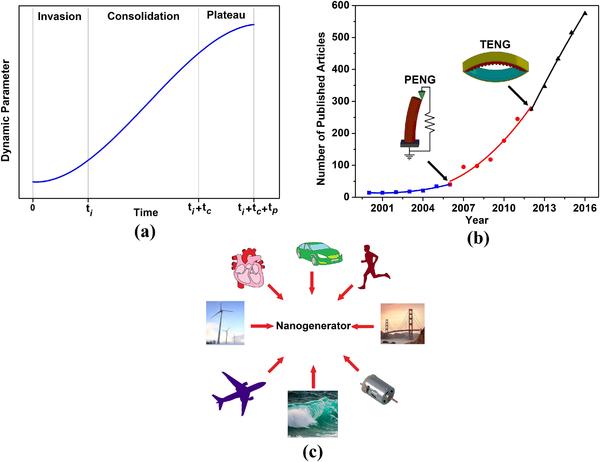
Trends of publications based on nanogenerators (Askari et al. Nano Today 2018)
Indeed, NGs have exhibited a significant impact on the field of energy harvesting and self-powered sensing. They have shown a promising potential for developing new systems in different applications such as kinetic energy harvesting, condition monitoring, biomedical systems, and portable devices. The high potential and capability of these two new techniques can lead to a plenty of new instruments in different systems. In fact, NGs can play the main role as a technology source for the development of future smart home, smart vehicles, smart healthcare, and smart electronics. Eventually, leveraging NGs can help us to fully actualize the smart cities of future.
Intelligent Tires
Tires are the interface between a vehicle and the ground providing forces and isolation to the vehicle. For vehicle safety, stability, maintenance, and performance, it is vital to estimate or measure tire forces, inflation pressure, and contact friction coefficient. Estimation methods can predict tire forces to some extent however; they fail in harsh maneuvers and are dependent on road surface conditions for which there is no robust estimation method. Measurement devices for tire forces exist for vehicle testing but at the cost of tens of thousands of dollars. Tire pressure-monitoring sensors (TPMS) are the only sensors available in newer and higher end vehicles to provide tire pressure, but there are no sensors to measure road surface condition or tire forces for production vehicles.
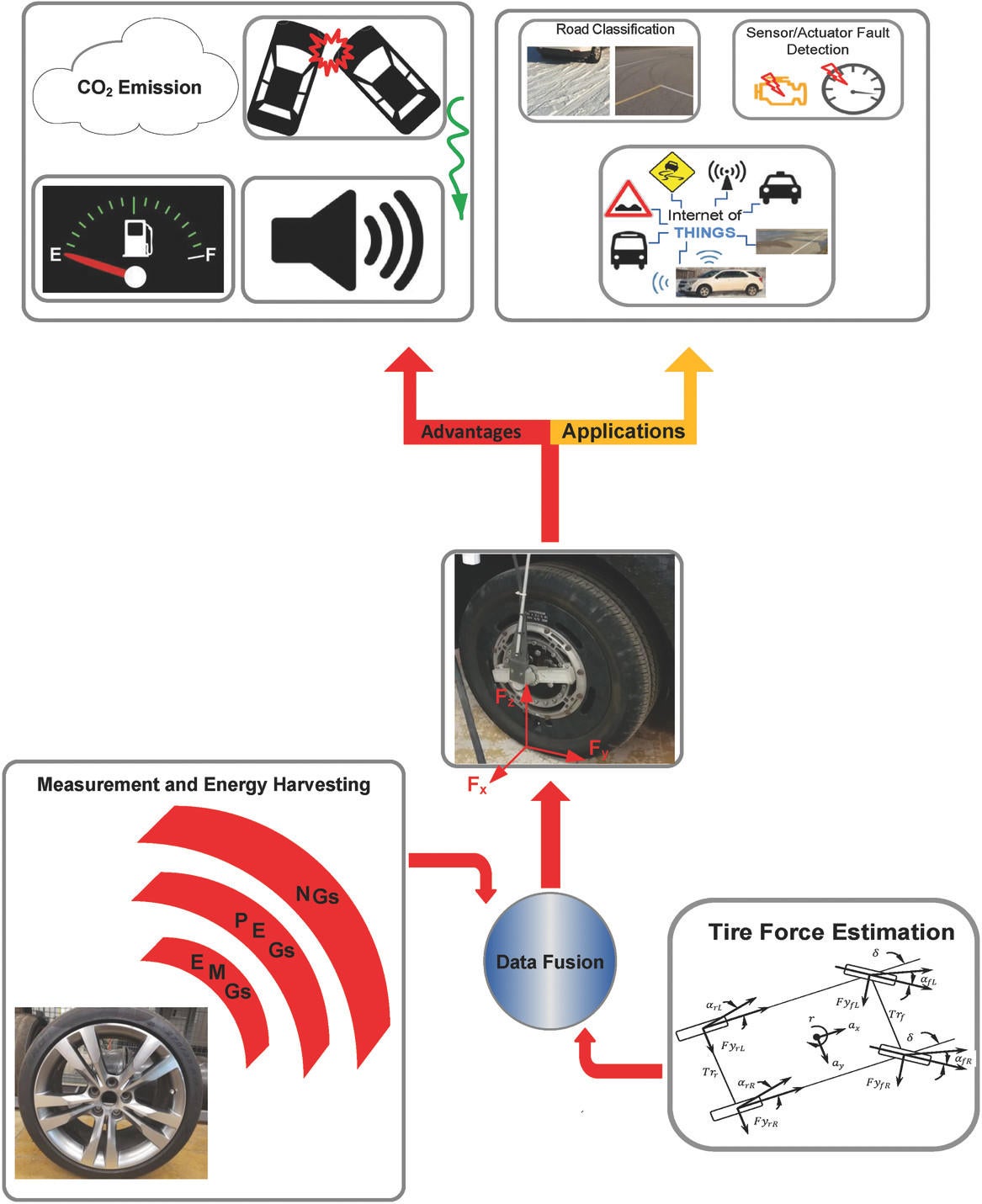
Intelligent Tires: Applications and Advantages (Askari et al. Advanced Materials Technologies 2018)
With the prospect of autonomous driving on roads in near future, it is paramount to make the vehicles safe on any driving and road condition. This is only possible by additional sensors to make up for the driver’s cognitive and sensory system. Measuring road condition and tire forces especially in autonomous vehicles are vital in their safety, reliability, and public confidence in automated driving. Real time measurement of road condition and tire forces in buses and trucks can significantly improve the safety of road transportation system, and in miming/construction and off-road vehicles can improve performance, tire life and reduce operational costs. Intelligent tires can provide a reliable information from tire-road interaction forces and road conditions which can be very useful in improving vehicle control and stability, and it is highly crucial for the realization of autonomous driving. In my PhD thesis, for the first time, I have developed a set of intelligent tire system based on the technology of nanogenerators in combination with machine learning with the aim of online measurement of tire forces. My research not only presents the potential of nanogenerators for tire-condition monitoring and road-interaction forces measurement, but also it provides a roadmap for researchers in the area of intelligent tire.
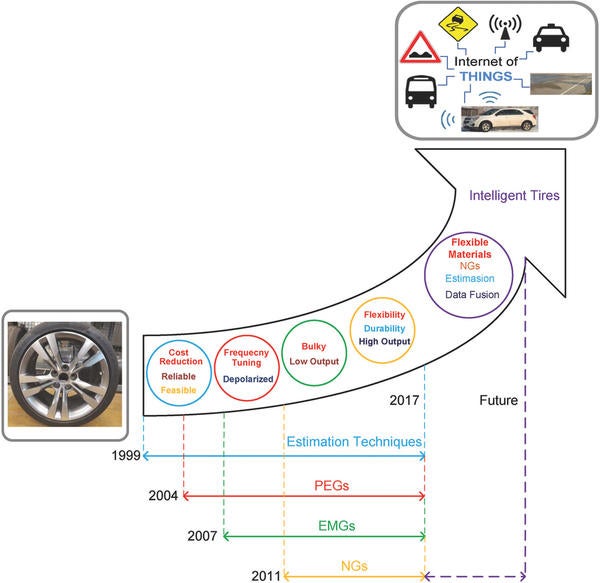 Evolution of Intelligent Tire (Askari et al. Advanced Materials Technologies 2018)
Evolution of Intelligent Tire (Askari et al. Advanced Materials Technologies 2018)
Intelligent Traffic Monitoring
Advances in applications of sensor technologies, connected vehicles, and WSN in intelligent transportation systems facilitate reliable and robust traffic monitoring, which needs a reliable source of energy. This need is even more pronounced in remote areas and harsh environment where maintenance of power sources in sensor networks is hard. Combination of TENG and EMG in a single package presented would actualize the self-powered sensing with using in speed bumpers or even road pavement. One conceptual design for this application is a hybridized electromagnetic-triboelectric energy harvesting device, which encompasses advantageous of both electromagnetic and triboelectric mechanisms. As car passes over the speed bumper or the road pavement equipped with the self-powered generator, the proposed power harvesting mechanism scavenges energy from mechanical vibration in the speed bumpers due to the load of passing vehicles, and converts it into useful electrical signal for traffic monitoring purposes.
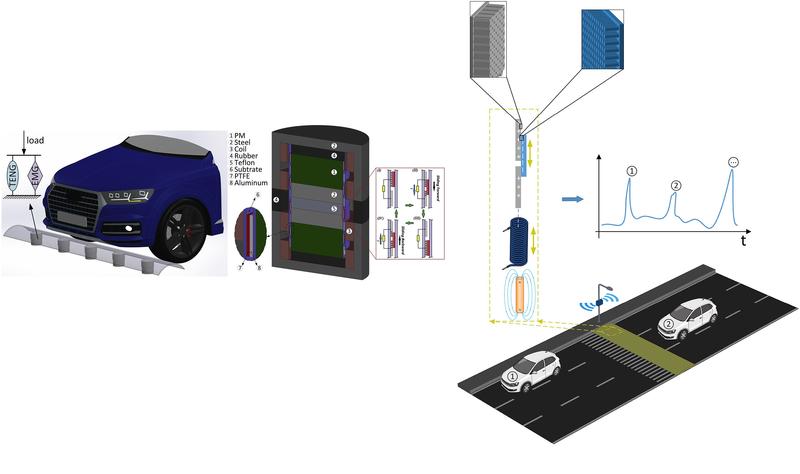
Intelligent Traffic Monitoring (Askari et al. Nano Energy 2018, Nano Energy 2019)
Smart Vehicles of Future
With the current changes in the automotive industry, vehicles need more and more advanced sensors for control, safety, monitoring, perception, and operation. With the current technological advancements, our cars are becoming more computers on wheels. There are more than one hundred sensors in a vehicle that many of them have the potential to be replaced with nanogenerators (NGs)-based self-powered sensors. Nanogenerators have shown a substantial potential for developing new types of sensors, and even, they can be utilized for developing a number of novel sensors in vehicle and intelligent transportation systems. Indeed, the pace of development of self-powered sensing devices is brisk, and it would have a substantial impact on automotive sensing systems. Reduction of wiring, increasing vehicle safety, and expediting the technology of connected vehicles and intelligent transportation would be a few advantages of the utilization of NGs in automotive sensing systems.
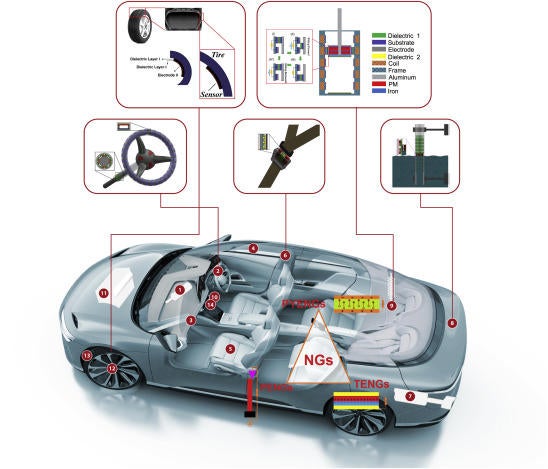
Smart Vehicles with Self-powered sensors (Askari et al. Nano Energy, 2019)
Nonlinear Oscillations
Nonlinear oscillations emerge in several systems with applications in automotive, sensing, fluid-solid interaction, aerospace, micro- and nanoscale, and bioengineering. Exploring the physics and mathematics of nonlinearity in different dynamics systems helps to better understand the enigmatic behavior of our nature. I have started exploring nonlinear systems and phenomena at the age of twenty with the focus on nonlinearity in macro-structures oscillatory systems, low dimensional systems and nanostructures, and generalized nonlinear oscillatory systems. I have been very lucky to have the chance to work with well-known professors in field of nonlinear oscillations such as Prof. E. Esmailzadeh, Prof. D. Younesian, and Prof. L. Cveticanin. Working with them helped me to enrich my knowledge in the above-mentioned fields, which resulted in 1 book, 1 book chapters, and more than 35 journal articles and conference papers. My co-authored book, Analytical Method in Nonlinear Oscillations, with Prof. Esmailzadeh and Prof. Younesian, covers a wide range of classical and modern techniques for analyzing nonlinear oscillation in different dynamical systems.
Nonlinearity in Macro Stuctures
Nonlinearity in macro-structures arises becuase of two main sources either physical properties or large oscillations. In my research, I have studied nonlinear oscillations in different macro-structures taking into acount the above-mentioned sources of nonlinearity and different forms of external excitations. Links below provide some of my latest works on nonlinear oscillations in macro-structures:
a) Elastic and Viscoelastic Foundation in Nonlinear Dynamics
b) A Unified Approach for Curved Structures in the Journal of Sound and Vibration
c) Multi-Frequency Excitations of Triangular Plates in the Jounral of Sound and Vibration
d) Nonlinear Oscillations of Beams on Nonlinear Foundations in the Journal of Theoritical and Applied Mechanics
e) Two-mass System with Non-integer Order Nonlinear Connection in Mechanics Research Communications
Nonlinearity in Low Dimensional Systems and Nanostructures
Nonlinearity in low dimensional systems and nanostructures emerges because of high sensitivity to small perturbation and physical properties. In my research, I have scrutinized the nonlinear behavior in these types of structures, and its importance in high-resolution mass sensing. Links below presents some of my latest research in the above-mentioned topic:
a) Nonlinear Vibrations of Fluid Conveying Nanotubes in Composite Part B: Engineering
b) Nonlinear Vibrations of Nonlocal Nanowires in Composite Part B: Engineering
c) Multi-Frequency Excitations of Microbeam in the Journal of Vibration and Control
d) High Resolution Mass Identification in Measurement
Generalized Nonlinear Oscillatory Systems
Generalized nonlinear systems cover a wide range of resonators with applications in structural systems, bio-devices, physics, optics and acoustics. In my research, I have either studied or developed novel generalized nonlinear systems with the aim of providing a compact from of mathematical representation, which contains several simplified forms of oscillatory systems. In addition, closed form solutions are presented for all the developed generalized oscillators. Below are some of the generalized nonlinear oscillatory systems that I have either studied or proposed.
a) Generalized Duffing Equation in Computers & Mathematics with Applications
\(\ddot x+\sum_{i=0}^{n}\alpha_{2i+1}x^{2i+1}=0\)
b) Generalized Oscillators with Strong Nonlinear Terms in Journal of Engineering Mathematics
\(\ddot x + \sum_i c_i^2 x|x|^{i-1}=0, i>0 \)
c) Oscillators with Generalized Geometrical and Inertial Nonlinearities in Nonlinear Approaches in Engineering Applications
\(\ddot x+\sum_{j=1,2,3,...;q=2j+1}^n \alpha_j x^q+\sum_{i=1,2,3,...;k=2i;p=k-1}^m[x^k\ddot{x}+kx^p\dot{x}/2]=0\)
d) Generalized Relativistic Oscillator in Applicable Analysis
\(\ddot x+\delta x+\Omega x^n+\frac{\lambda x^{m-1}}{\sqrt{x^m+\alpha}}=0, n=2k-1, m=2k, k=1,2,3,...\)
e) Generalized Irrational Oscillator in Analytical Methods in Nonlinear Oscillations
\(\ddot{x}+\beta x+x^{2n-1}\sqrt{1+\epsilon^2x^{4n}}=0, n=1,2,3,...\)